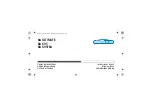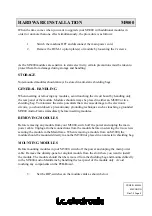
13
Liquid nitrogen is extremely cold. Make sure to wear proper gear before operation. Avoid spilling
liquid nitrogen over the vacuum port as this can shrink the seal and allow air to leak into the vacuum
space causing premature vacuum failure. To ensure maximum performance from your MVE Vapor
Shipper simply follow the listed steps prior to shipping to final destination:
1. Open container that the Vapor Shipper is in, open the lid, and remove cork/cover/accessories.
Lift cork/cover straight up (do not twist).
2. Fill unit to bottom of neck tube.
a. If you are working with a warm vessel, it is MVE’s recommendation to slowly add small
amount of liquid to the bottom of unit, and allow it to sit until the liquid nitrogen stops
rapidly boiling to cool the unit. Position the vacuum port facing away from the operator or
other personnel.
b. To obtain the optimized Hold time. You will need to refill the unit to bottom of the neck
more than once until the liquid level is steady.
c. Follow established safety practices and procedures for transferring LN2.
d. Fill the vessel with a funnel or transfer line when possible. Transfer using LN2 hose with
phase separator or pouring container using a funnel.
e. If you are filling your vessel from a pressurized source, make sure it is a low pressure
source (1.52 bar or below).
3. Replace cork/cover and allow unit to reach thermal equilibrium /charge for minimal 24 hours.
a. Refer to
UTILIZING THE QWICK CHARGE TECHNOLOGY
section for expedited charge solution.
b. If there is excessive frost or sweating on the outside vessel after the first few hours, it
would indicate either a weak or no vacuum. Examine the unit carefully.
4. Pour off excess liquid just prior to shipment.
a. If necessary to completely dispense all liquid nitrogen, invert the unit until liquid nitrogen
dripping has stopped, set the unit upright and view if any liquid nitrogen pools at the
bottom of the unit. If liquid nitrogen starts to pool, invert the unit again. Repeat as
necessary until all liquid nitrogen is removed from the unit, in accordance with ICAO
Packaging Instruction 202.
5. Weigh unit and record.
a. To ensure a proper charging process is conducted, obtain both empty and charged
weights. Verify the differential between empty and charged weights is close to data in
Table 1. The differential can be calculated by using Equation 1.
Differential = Charged Weight — Empty Weight
Equation 1
b. Please note that the Charged Weight is not an indication of unit performance.
6. Place inventories into unit, replace cork/cover and lid.
UTILIZING THE QWICK CHARGE TECHNOLOGY
Only units bearing QWICK charge label is equipped with QWICK charge technology
. To utilize the
QWick Charge Technology and charge in under 2 hours, do not allow unit to warm up above -150°C
between shipments. If the inside of the unit is above -150°C, it will need to be charged again for a
minimal of 24 hours to allow the unit to reach thermal equilibrium.
Use the following weight table as a general guide to determine if your Vapor Shipper is fully charged.
Values are for reference only. Weights can vary depending on the charging process. Refer to the Static
hold time and Normal Evaporation Rate (NER) specifications listed in the table below. Factors such as
age of unit, quantity of inventory, ambient environment, shipping condition, and use of accessories,
etc. can negatively affect unit Hold time and NER. If you do not find your model listed here, refer to
the MVE Cryopreservation Catalog or contact Customer or Technical Service for assistance.
12
SAFETY
WARNING:
Liquid nitrogen is extremely cold. To avoid injury by frostbite, use extreme care
whenever handling liquid nitrogen, liquid nitrogen storage or transfer vessels, or any objects
which have come in contact with liquid nitrogen.
•
Leave no area of skin exposed.
•
Always wear proper safety attire over clothing: face shield, cryogenic gloves, and
cryogenic apron.
•
Use extreme care to prevent spilling and splashing liquid nitrogen during transfer.
•
Always keep vessel in upright position. Do not tilt, or lay the vessel on side.
•
Immediately remove any clothing or safety attire on which liquid nitrogen has spilled.
•
Get immediate medical attention for any frostbite injuries due to liquid nitrogen.
WARNING:
The venting of nitrogen vapors may deplete oxygen in the air, possibly leading to
asphyxiation or even death. Do not store or use container in areas that are small and enclosed
or have poor ventilation.
WARNING:
Do not tightly seal liquid nitrogen container or prevent nitrogen gas from escaping.
Also, excessive humidity levels or exposure to rainfall could result in freezing of the cork/cover,
and possible explosion.
WARNING:
Never use a hollow tube to measure liquid nitrogen level. This could lead to thermal
injury.
CAUTION:
Handle the cryopreservation vessel with care.
•
Never overfill vessels with liquid nitrogen. Liquid nitrogen should always be below the
bottom of the neck tube. Overfilling the tank may cause immediate or premature
vacuum failure to occur.
•
Never ship Vapor Shipper on its side or upside down. This can lead to vacuum failure
and loss of product inside the Vapor Shipper.
•
Do not scratch neck tube area. Remove and insert inventories carefully. Scratches can
cause premature vacuum failure.
•
Tampering with or removing the vacuum port will destroy vacuum and void warranty.
•
Never drop, hit, or blow the vessel.
•
Never spill liquid nitrogen on or near vacuum port.
•
Never leave the vessel in an outdoor condition.
•
Inspect vessel for any damage before and after each shipment.
•
Keep the bottom of vessel clean and away from chemicals, fertilizers, soil, and moisture.
•
All performance data published for these products is based on static conditions only.
Actual performance will vary upon the nature of use. Manipulation of inventories and
or accessories along with vibration will decrease the working duration/Hold time of
these products.
OPERATION
CAUTION:
Consider the value of the inventory when shipping and determine if the inventory
should be split between multiple containers to reduce the risk of losing valuable and/or
irreplaceable products should the container become delayed, lost, or damaged in shipping.
CAUTION:
Do not use dewars for longterm storage of human biological contents. Failure to follow
Chart’s best operating practices, as set forth in the operating manual, can result in loss of contents.








































